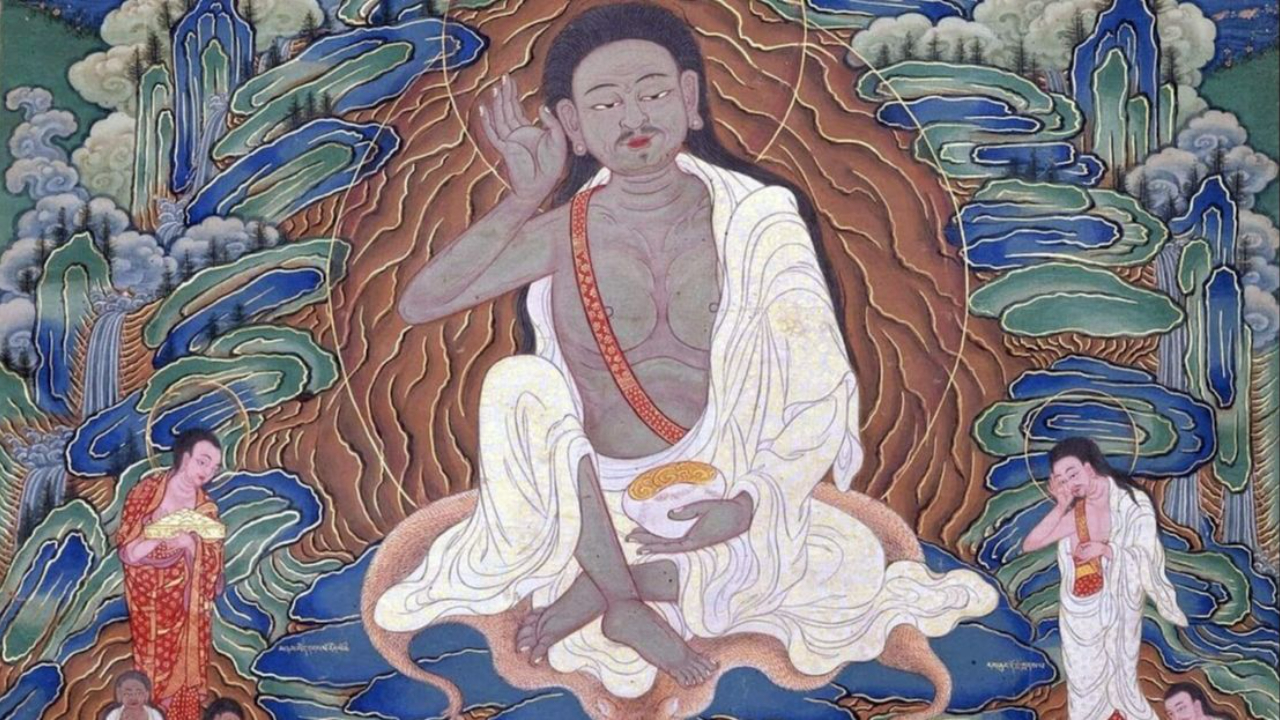The Psychology of the Buddha’s and the Journey to No-Mind with Osho
May 19, 2025
At the heart of Tantra Essence is the union of Meditation and Love. Meditation represents the silent, steady awareness within us, often called the masculine principle.
It is the part of us that watches without reacting, the quiet witness that sees thoughts, emotions, and sensations come and go, without clinging, without judgment.
Love, devotion, and surrender express the feminine principle. They are the living currents of openness, the willingness to feel, to lean into life fully, to allow experience to flow through us without fear or resistance.
When these two forces, silent witnessing and vibrant openness, are woven together, the soul begins to remember itself not as broken or divided, but as whole, alive, and intimately connected to life.
At Tantra Essence, this meeting of Meditation and Love is a lived, felt reality, and it creates the perfect ground for one of the deepest pillars of the work, the Psychology of the Buddhas.
What is Buddha Psychology?
The Psychology of the Buddhas is the study and path of moving beyond the mind entirely, beyond thoughts, emotions, memories, and the unconscious patterns that usually define human experience. Instead of helping a person adjust to their wounds or manage their trauma, it guides them into the direct experience of Buddha Nature: the silent, unbroken awareness at the core of their being.
In this state of pure witnessing, true healing happens, not by fixing the mind, but by stepping into a dimension where the mind no longer controls life. The Psychology of the Buddhas is a path to transcend the mind, and to live from a place of freedom, wholeness, and natural joy.
In traditional therapy, the journey often moves from the conscious mind into the subconscious, into the dense terrain of memories, traumas, repressed instincts. It touches the wounds that shaped us but often circles endlessly within them. The aim is typically to return to the surface, a little more aware, a little better adapted, but still caught within the narrow field of mind.
Inside the subconscious lie the echoes of ancestral grief, birth trauma, past lives, even the primal cries of the animal unconscious. Therapy may stir these layers, but rarely does it clear them at the root. More often, it leaves the person managing their pain rather than transcending it, tangled in a slow walk toward healing that never quite ends.
Osho shattered this endless loop when he saw that true healing, true transformation, demands we go beyond mind entirely. "Freud established only a psychology of pathology… my work was going further, trying to establish a psychology of the awakened one, a psychology of the Buddhas."
In the Psychology of the Buddhas, the work is not just to explore the mind, it is to transcend it. You are gently, powerfully introduced to meditation as the foundation of your journey. You are guided to drop beneath the conscious mind, move through the subconscious, and from there, step into an entirely different space, your Buddha Nature, vast, silent, luminous.
Pure Awareness of The Mind

This encounter with pure awareness is a lived experience, a taste of the great, open sky beyond the clouds of thought and feeling. And once tasted, something irreversible happens, traumas that once seemed solid begin to dissolve. Emotional wounds lose their gravity, memories are no longer chains, but simply passing echoes in a vast, untouchable space.
Osho says “The study of no-mind is just the study of an empty canvas. The thoughts are gone, the emotions are gone, the sentiments are gone, the moods are gone. Nothing is left except a pure, empty space.”
And crucially, the journey doesn't end in transcendence. In the Psychology of the Buddhas, one returns, carrying the fragrance of Buddha Nature back into the subconscious, into the conscious mind, into every corner of daily life. This integration transforms the person from within by allowing a new, more authentic being to emerge.
This is the path Tantra Essence invites you into. Not endless repair, but radical rebirth. Not circling wounds, but stepping beyond them. Love and Meditation intertwined, guiding the soul home, whole, awake, and overflowing with life.
The Origins of the Psychology of the Buddhas
The origin of this psychology lies in the lived experiences of ancient awakened masters, particularly Gautam Buddha, whose teachings described how desire, ignorance, and unconscious habit keep human beings trapped in suffering.
Buddha pointed to the process of observing mind, moving through its illusions, and reaching a state of no-self, or nirvana. However, while Buddha and others lived this journey, they did not frame it in psychological terms or structure it as a system of internal development.
Osho was the one who recognized that the inner path walked by the Buddhas could, in fact, be mapped with the precision of a true psychology, a psychology not of illness, but of awakening.
In the 1960s and 70s, while working with thousands of seekers through meditation camps and personal guidance, Osho observed that modern individuals were stuck at specific layers of the mind, the conscious mind shaped by social conditioning, the subconscious mind burdened with repressed traumas and fears, and the collective unconscious carrying ancestral and evolutionary patterns.
He saw that unless these layers were consciously crossed, real meditation was impossible. And he saw that beyond these layers, when seekers broke through, they touched states of superconsciousness and eventually entered the vastness of no-mind, the same inner flowering Buddha had lived.
Through these observations, and through his own inner experience, Osho formulated the Psychology of the Buddhas, a clear, living map that shows how a human being moves from the mind’s bondage into freedom.
He found it in the direct, daily work of watching real people struggle, surrender, awaken, and he gave language to what had previously been transmitted only through silence or spiritual metaphor. The Psychology of the Buddhas became the foundation behind all of Osho’s work.
Beyond Freud: From the Unconscious Mind to the Psychology of the Buddhas
Freud’s contribution to psychology was monumental, but partial. He discovered the unconscious mind, a realm of hidden desires, repressed instincts, and unresolved conflicts operating beneath the facade of civilized life. Through the study of dreams, Freud realized that human beings live divided lives, saying one thing, feeling another; performing roles on the outside while carrying forbidden urges on the inside.
For the first time in Western history, the mind’s psychology was named. Freud revealed that the conscious mind is not master of itself, but merely the visible tip of a much larger, unseen reality.
And yet, Freud’s vision remained trapped within the pathology of mind. His psychoanalysis was an endless excavation of symptoms, dreams, repressions, an attempt to make the unconscious conscious, but not to transcend it. The client in Freudian therapy might become more self-aware, but they would remain entangled in the machinery of mind.
As Osho points out, Freud could only uncover the basement. He did not know, could not yet conceive, that beyond the dark layers of the unconscious lies an entirely different dimension of being. “Western psychology is still wandering around the roots; it has not even touched the foliage, the flowers, the fruits.”
Later thinkers like Carl Jung expanded Freud’s insights by introducing the concept of the collective unconscious, the inherited memory of humanity, a vast psychic field connecting all beings across generations. Jung glimpsed that the unconscious was not purely personal but collective, containing the residues of ancestral experiences, mythological symbols, and evolutionary instincts.
Even so, Jung’s exploration remained confined to the lower floors of the psyche. The real breakthrough—the path beyond suffering—remained hidden to Western psychology.
Mapping the True Inner Journey: Osho’s Psychology of the Buddhas
"All the psychologies are of the mind. The psychology of the Buddhas will be of the no-mind. It is going to be diametrically opposite to the ordinary psychologies in every aspect, in every direction, because it is a totally new dimension — never touched before." – Osho
Long before the discoveries of Freud and Jung, Eastern mystics had already explored and mapped the hidden architecture of the human psyche. They understood that beneath the surface of ordinary awareness lie multiple layers of mind, each carrying its own weight of conditioning, memory, and unconscious movement.
The first layer they described is the unconscious mind, the realm where personal repressions, fears, forgotten traumas, and unresolved emotional currents are stored. Beneath this lies the collective unconscious, a deeper field that holds the inherited memories of humanity itself, ancestral wounds, evolutionary fears, patterns of behavior that span lifetimes.
And deeper still, the psychic space of the cosmic collective unconscious, the imprint of existence itself on human consciousness, carrying forces and movements older than personal or ancestral life.
Yet where modern psychology often stops at diagnosis, the Eastern vision pointed further, toward the possibility of ascending beyond these layers altogether. Above the ordinary mind, they recognized the opening of the superconscious, moments of sudden clarity, intuitive knowing, and expanded perception that seemed to come from beyond the personal mind.
Moving deeper into this ascent, they described the collective superconscious, a shared field of awakened consciousness, where the boundaries between "I" and "you" begin to dissolve, and an individual's awareness merges into a larger current of being. At its highest point, they touched the cosmic superconscious, the state where the seeker no longer feels separate from existence, but lives as an expression of life itself.
The State of No Mind
"No-mind is not simply emptiness. It is full, overfull with all the potentialities. It is the very source of all creation." - Osho
Osho made it clear that beyond all seven layers, unconscious, collective unconscious, cosmic unconscious, superconscious, collective superconscious, cosmic superconscious, lies the state of no-mind.
No-mind is not simply a higher state of mind. It is the complete dropping of mind itself: a pure, living awareness without content, without thoughts, without divisions. It is not unconscious, because there is full presence. It is not superconscious, because even the experience of heightened states has fallen away. It is a direct encounter with reality as it is, raw, silent, overflowing with life, yet completely still.
In no-mind, trauma cannot survive, because the structure that holds trauma, the personal mind, is no longer functioning. Repression dissolves because the divided self, the one who hides from itself, no longer exists. Healing is not something achieved through effort; it rises naturally, like fragrance from a flower, when the false layers fall away.
This vision forms the foundation of what Osho calls the Psychology of the Buddhas. It is not a psychology concerned with repairing the mind's injuries, or endlessly processing the contents of the unconscious. It is a psychology of transcendence, of moving so deeply into awareness that mind, memory, history, and even identity themselves are seen through and left behind.
Beyond the Mind: True Integration Through the Psychology of the Buddhas
In the Psychology of the Buddhas, the therapist or facilitator is not concerned with helping you adjust to a fractured world. Nor are they simply unearthing memories, rehashing wounds, or endlessly analyzing dreams. Their task is to guide you through the layers of mind, the conscious, the subconscious, the collective unconscious, and beyond all of them, into the silent, luminous vastness of no-mind.
First, you are taught to witness the surface mind, the restless movements of conditioning and survival. You are then led through the dense fields of the subconscious, where ancestral wounds and buried fears live. But critically, you are not trapped there.
You are invited to step beyond mind itself. You are led to taste the open sky of Buddha Nature: a vast, silent presence that has never been wounded, never been divided, never been touched by history.
In this experience, healing happens through dissolving the architecture that clung to wounds in the first place. Trauma loses its reality. Dreams lose their grip. The fractured self evaporates.
Yet transcendence is not escape. The Psychology of the Buddhas teaches you to bring the fragrance of this vastness back:
- To saturate the subconscious with the light of witnessing.
- To infuse the conscious mind with presence and clarity.
- To live from a center that is no longer organized around pain, but around pure being.
What Does It Mean To Be Trauma-Informed, and Why Is It Only the Beginning?
In recent years, there has been a growing and much-needed movement toward making healing practices "trauma-informed." This shift recognizes that many individuals carry unseen wounds, from childhood neglect, emotional betrayal, violence, oppression, and countless other ruptures, and that these wounds shape behavior, emotion, and even perception itself.
Being trauma-informed means acknowledging that healing cannot be forced. It means recognizing the importance of creating safe spaces, pacing growth carefully, and understanding how survival adaptations like dissociation, hypervigilance, and emotional numbing are strategies developed by the body and mind to survive the unbearable.
This shift marks a deeper compassion entering the fields of therapy, coaching, education, and personal development. But it is also important to understand, being trauma-informed is a beginning, not an end. Because trauma-informed work, by its nature, still works inside the architecture of the mind. It helps the wounded personality function better, it helps the nervous system regulate, it helps the emotional body gather ground. But the self that was wounded, the personal mind, remains the center of the work.
No matter how safe, how gradual, how insightful the process, it remains within the field of managing, healing, or reorganizing the structure built around trauma. True liberation demands something more. It demands that we move not just toward a healthier self, but beyond the self that was wounded.
Meditation and Buddha Psychology

Rather than revolving endlessly around the wounded structures of mind, Buddha psychology invites the seeker into a direct experience of the awareness that has never been wounded. The silent, witnessing consciousness that was present before the trauma, during the trauma, and remains present even now, unchanged.
Meditation, in this vision, is the bridge across the entire architecture of mind, from the conscious and subconscious patterns built through personal history, through the ancestral and evolutionary memories of the collective unconscious, into the superconscious, and ultimately into the pure, silent reality of no-mind.
Osho says: "Just as through dreams Freud reached to the unconscious mind, through meditation man can reach to the superconscious mind."
At this level, healing is not effortful. It is a natural consequence of seeing that the core of your being was never broken. When a person touches Buddha Nature, even for a moment, gratitude arises, not because they are told to be grateful, but because existence itself feels like an impossible gift.
Love flows as an overflowing of the silent richness inside. Old wounds lose their centrality because the center from which they seemed important is no longer gripping consciousness. The world no longer feels like a battlefield to survive. It feels like an unfolding mystery to live.
The Psychology of the Buddhas does not aim to treat trauma, it aims to reveal the part of you that trauma could never touch. It does not manage the mind, it dissolves the tyranny of the mind altogether.
For Those Called To This Path:
- Explore Osho’s discourse on The Psychology of the Buddhas.
- Deepen emotional integration through the Emotional Fluidity Online Course by Ananda Sarita. (Coming soon!)
- Discover practical meditation-based healing with Brandon Bays’ Freedom Is.
Conclusion
The Psychology of the Buddhas offers a direct path of self-discovery, showing us how to step beyond the mind that creates suffering in the first place.
"To attain to no-mind is to attain all. There is nothing more than that, because it is peace, it is silence, it is blissfulness. It is godliness, it is immortality, it is eternity. No-mind is all that is possible."
Osho's insight shows us that healing at the level of the mind will always be limited. Real healing begins when we touch the silent, witnessing consciousness at our core.
Through meditation, through the integration of witnessing and love, we are guided beyond survival patterns, beyond inherited suffering, beyond the unconscious forces that quietly shape our lives.
We learn to live from an entirely different center. The Psychology of the Buddhas promises a life lived from a consciousness that cannot be shaken by challenge.
For those ready to walk this path, the doorway is already here. It begins with meditation, it deepens through love. And it leads to home, to the place within you that has always been wanting to be lived fully.
FAQ
The Psychology of the Buddha, or Buddha Psychology, is the understanding of how human beings can move beyond suffering by transcending the layers of mind itself. Unlike western psychology, which often focuses on adjusting behaviors or managing mental health symptoms, Buddhist psychology points toward awakening the silent awareness at the center of our being.
The three central beliefs in Buddhist philosophy, sometimes called the Three Marks of Existence, are:
- Anicca (impermanence): everything, including mental processes, is constantly changing.
- Dukkha (suffering): suffering is inevitable as long as we cling to transient things.
- Anatta (non-self): there is no fixed, permanent self; the self is a process, not a thing.
Buddha taught that understanding these truths leads to liberation. Modern psychology often focuses on solidifying or strengthening identity structures, but Buddhist concepts invite us to question them entirely. Meditation practices grounded in these teachings, such as mindfulness practices and Buddhist mindfulness techniques, help dissolve attachment and bring clarity to the present moment.
Buddhist psychology is increasingly finding validation through modern science and psychological treatments. Fields like mindfulness-based cognitive therapy (MBCT), mindfulness-based stress reduction (MBSR) from the Massachusetts Medical Center, and dialectical behavioral therapy (DBT) draw directly from Buddhist mindfulness practices.
Research shows that Buddhist meditation and mindfulness practices improve mental health, reduce anxiety, regulate emotions, and increase positive emotions and feelings of well-being. Although Buddhism’s psychological orientation comes from spiritual traditions, its impact on the human mind is now widely acknowledged in clinical psychology, cognitive therapy, and even existential psychology.
In many ways, Gautama Buddha, the historical Buddha who lived in India around the 5th to 6th century BCE, can be seen as the world’s first existential psychologist. While not a “psychologist” in the modern clinical psychology sense, Gautama Buddha deeply explored the roots of human suffering, mental processes, emotional conditioning, and the fundamental nature of reality.
His teachings, particularly the Four Noble Truths offer a precise, experiential examination of why human beings suffer and how they can move beyond suffering. Rather than proposing a belief system, Buddha presented a practical methodology for understanding and transforming the human mind, which has strong parallels with what later became existential psychology and phenomenological psychology.
Many Buddhist scholars and modern thinkers recognize that Buddhist thought provides one of the most sophisticated psychological models ever developed, long before the appearance of western psychological practice, clinical psychology, or modern science.
His teachings were then enlarged on through the efforts of great teachers like Atisha, who dedicated his life to creating methods for alleviating and transcending human suffering, or the great linage of Zen, whose masters have created a remarkable path of bringing the pure light of awareness into every aspect of life, from flower arranging to tea drinking, gardening, martial arts, food preparation and building.
Osho brought into his community and teachings an awareness and practice of bridging modern therapy with ancient wisdom teachings. In deepest gratitude, I bow down to Osho, to Buddha and to all of the enlightened ones, who have worked tirelessly across generations, to bring us their precious jewels of transcendent wisdom.















